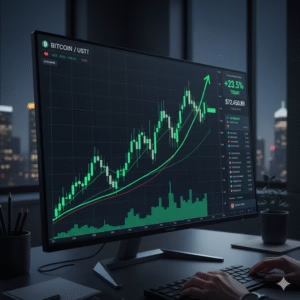Learn about the key sectors to keep an eye on as you enter the new year
Take a look at which sectors to keep an eye on at the beginning of 2026

As the calendar turns, investors, business owners, and savvy consumers alike begin the ritual of looking ahead. We review our budgets, assess our portfolios, and ask the big question: “Where is the smart money going?”
The end of one year and the beginning of another is the perfect time to evaluate the economic landscape. It’s not about finding a “get rich quick” scheme; it’s about understanding the deep, structural shifts that create lasting trends. While no one has a crystal ball, we can identify powerful forces—like demographic shifts, technological innovation, and new government policies—that are set to shape the market.
Understanding these forces helps you position your finances, whether you’re investing in your 401(k), picking stocks, or even considering a career change. It’s about separating the fleeting headlines from the long-term transformations.
This article will break down the primary economic sectors poised for significant attention in the coming year. We’ll explore why they matter, what the key drivers are, and how you can think about them as part of a balanced financial picture.
1. The AI Revolution: Why Technology Remains a Top Sector to Watch

It’s impossible to discuss the future without starting here. While Artificial Intelligence (AI) dominated headlines last year, we are now moving from the “wow” phase to the “how” phase. The coming year will be defined by implementation and adoption.
Previously, AI was a concept; now, it’s a tool. Companies across every industry are scrambling to integrate AI to boost efficiency, create new products, and gain a competitive edge. This isn’t just a trend for tech companies; it’s a fundamental utility, much like the internet or cloud computing.
Where to Look Within Tech:
- Generative AI and Large Language Models (LLMs): These are the brains behind tools like ChatGPT. The next wave will be enterprise-grade AI. Think of AI assistants for doctors that summarize patient notes, AI for lawyers that perform legal research in seconds, and AI for coders that write and debug software. Companies that provide these specialized, secure AI services are a core partof this trend.
- The “Picks and Shovels” (Semiconductors): AI models are incredibly power-hungry. They require specialized computer chips known as GPUs (Graphics Processing Units). Companies that design and manufacture these high-performance chips are the “picks and shovels” of the AI gold rush. Without them, the entire revolution grinds to a halt.
- Cloud Infrastructure: Where does all this AI processing happen? In the cloud. Major cloud providers (like Amazon’s AWS, Microsoft’s Azure, and Google Cloud) are in an arms race to offer the best, fastest, and most secure AI platforms. Their growth is directly tied to the adoption of AI, as businesses rent “supercomputer” time from them instead of building their own.
For the average person, this means your job may soon involve an AI co-pilot, and the services you use will become smarter and more personalized. For investors, it means looking at the foundational companies that are building this new digital infrastructure.
2. Healthcare Innovation: Investing in Longevity and Digital Health
The healthcare sector is driven by two unshakeable, long-term trends: an aging population and technological breakthroughs.
First, demographics. The Baby Boomer generation is entering its senior years, leading to a massive, sustained increase in demand for healthcare services, from routine check-ups to complex surgeries and pharmaceuticals. This demographic wave is a powerful tailwind for the entire sector.
Second, technology is fundamentally changing how healthcare is delivered. The coming year will see a deeper integration of data, AI, and personalized medicine.
Key Areas in Healthcare:
- Biotechnology and “New” Pharma: We are moving away from one-size-fits-all medicine. The spotlight is on technologies like mRNA (made famous by COVID-19 vaccines) and gene editing (like CRISPR). These platforms are being used to develop treatments for complex diseases like cancer, Alzheimer’s, and rare genetic disorders. Companies in this space are high-risk but offer revolutionary potential.
- Medical Devices and Diagnostics: This sub-sector includes everything from robotic-assisted surgery systems that allow for more precise, less invasive procedures to next-generation glucose monitors for diabetics. As AI improves, diagnostics are also getting a boost. AI algorithms can now scan medical images (like X-rays or MRIs) and spot signs of disease earlier and more accurately than the human eye.
- Telehealth and Digital Health Management: The pandemic forced telehealth into the mainstream, but now it’s evolving. The next step is “digital health”—using wearables (like smartwatches) to monitor vital signs 24/7, integrating that data with your electronic health records, and allowing doctors to monitor chronic conditions remotely. This shift makes healthcare more preventative, convenient, and data-driven.
3. The Green Transition: Uncovering Opportunities in Renewable Energy
The global shift from fossil fuels to clean energy is one of the largest capital reallocations in human history. This isn’t a political statement; it’s an economic one. Driven by government incentives (like the Inflation Reduction Act in the U.S.), falling costs, and consumer demand, the “green transition” is a multi-decade mega-trend.
In the coming year, the focus will intensify on the infrastructure and technology needed to make this transition a reality.
Hotspots in the Energy Sector:
- Electrification and Grid Modernization: It’s not just about building more solar panels and wind turbines. We have to get that power to homes and businesses. The U.S. electrical grid is aging, and it needs a massive upgrade to handle the increased load from electric vehicles (EVs) and electric heating. Companies involved in smart grid technology, high-voltage transformers, and energy management software are essential.
- Battery Storage: This is the lynchpin of the renewable revolution. The sun doesn’t always shine, and the wind doesn’t always blow. We need massive, grid-scale batteries to store excess energy and release it when demand is high. The technology for these batteries is improving rapidly, and the demand for the raw materials (like lithium, copper, and cobalt) is soaring.
- Nuclear Energy’s Resurgence: After decades of stigma, nuclear power is having a major comeback. It is the only form of 100% reliable, zero-carbon, base-load power. As countries and utilities realize that renewables alone can’t meet 24/7 demand, there is a new surge of interest in both traditional large-scale nuclear plants and new, smaller “Small Modular Reactors” (SMRs).
4. Cybersecurity: The Non-Negotiable Growth Sector in a Digital World

If every company is becoming a tech company, then every company is also becoming a target. The cost of a single data breach—in fines, lost business, and reputational damage—can be devastating.
As we connect everything to the internet (phones, cars, hospitals, and power grids) and embrace AI, our “attack surface” explodes. Cybersecurity has shifted from an IT “cost center” to a “must-have” C-suite priority. This sector benefits from a simple, unfortunate truth: as long as there are bad actors, the need for digital defense will only grow.
Sub-Sectors in Cybersecurity to Know:
- Cloud Security: As companies move their data off their own servers and into the cloud (like AWS or Azure), they need specialized tools to secure it. This is one of the fastest-growing segments of the cybersecurity market.
- Identity and Access Management (IAM): In a world of remote work, the new security perimeter isn’t the office building; it’s the user’s identity. IAM technologies (like multi-factor authentication) confirm that you are who you say you are before granting you access to sensitive data.
- AI-Driven Threat Detection: The bad guys are using AI to create more sophisticated phishing attacks and malware. The good guys are fighting back with their own AI, building systems that can monitor network traffic in real-time, identify unusual patterns, and neutralize threats before they can do damage.
5. Fintech and Digital Payments: How Money Itself is Evolving
Fintech (Financial Technology) is revolutionizing one of the oldest industries in the world: banking and finance. This sector is particularly relevant to anyone with a credit card, a loan, or a bank account—which is just about everyone.
The trend is about reducing friction. Consumers now expect to send money, get a loan, or buy insurance with a few taps on their phone. The companies building this new financial plumbing are positioned for massive growth.
Key Drivers in Fintech:
- The War on Cash (Digital Payments): While credit cards are old news, the infrastructure behind them is getting a major upgrade. “Buy Now, Pay Later” (BNPL) services are integrated into online checkouts. “Real-time payments” are allowing for instant bank transfers, not the 2-3 day wait we’re used to. Companies that process these transactions are at the center of all e-commerce.
- Embedded Finance: This is a subtle but powerful trend. It’s the idea of embedding financial products into non-financial apps. For example: when you buy a plane ticket and are offered travel insurance at checkout. Or when you use Tesla’s app to get an auto loan. The bank is disappearing into the background, and the software companies are the new face of finance.
- AI in Lending and Insurance (Insurtech): For decades, getting a loan or insurance policy was a slow, paper-based process. Now, AI models can analyze thousands of data points (beyond just a simple credit score) to assess risk in seconds. This allows lenders to approve more people, faster, and with greater accuracy.
6. Beyond the Headlines: Niche Sectors Poised for a Breakout
While the “big five” above will get most of the attention, smart investors also look for emerging trends. Here are a few niche sectors that are benefiting from powerful, under-the-radar shifts.
- Advanced Manufacturing and Robotics: For decades, manufacturing fled the U.S. in search of cheaper labor. That trend is reversing. Due to supply chain vulnerabilities (exposed by the pandemic) and geopolitical tensions, there’s a major push for “reshoring” or “onshoring”—bringing critical manufacturing back home. But U.S. labor is expensive. The solution? Automation. Companies that build the advanced robots, 3D printers, and automated factory systems are in high demand.
- Water Scarcity and Treatment: Water is arguably our most precious resource, and in many parts of the world (including the American West), it’s becoming increasingly scarce. This creates a critical need for companies involved in water technology: desalination (turning salt water into fresh water), advanced filtration, smart irrigation, and water infrastructure (fixing leaky pipes).
- The Pet Economy: This $100+ billion industry is driven by a simple trend: the “humanization” of pets. People are spending more on their pets than ever before, treating them as full-fledged family members. This fuels demand for premium and “human-grade” pet food, advanced veterinary care (including specialist treatments), pet insurance, and high-end accessories. It’s a remarkably resilient sector that tends to hold up well even during economic downturns.
7. How to Invest: Strategies for Sector-Based Investing in the New Year

So, you’re interested in these trends. How does the average person actually invest in a “sector”? You don’t necessarily have to pick individual “winning” stocks, which can be extremely risky.
For most people, the easiest and most diversified approach is through Exchange-Traded Funds (ETFs).
- What is a Sector ETF? An ETF is a “basket” of stocks that you can buy and sell as a single unit. A “Tech Sector ETF” might hold stocks in 100 different tech companies (like Apple, Microsoft, NVIDIA, etc.). A “Healthcare ETF” would hold a basket of pharmaceutical, biotech, and medical device companies.
- Why ETFs? They provide instant diversification. By buying one share of a Cybersecurity ETF, you get exposure to dozens of companies in that space. You are betting on the entire sector to grow, rather than trying to find the one company that will succeed. This significantly reduces your risk if one or two companies in the basket perform poorly.
- Niche vs. Broad: You can find broad ETFs (e.g., “The Technology Sector”) or very niche ones (e.g., “The Semiconductor ETF” or “The AI & Robotics ETF”). The more niche you get, the higher the potential risk and reward.
Of course, ETFs are just one tool. You can also invest through mutual funds or, if you have the expertise and risk tolerance, by researching and purchasing individual stocks.
8. Balancing Your Portfolio: The Inherent Risks of Sector-Specific Bets
It’s exciting to look at high-growth sectors, but it’s crucial to approach them with a healthy dose of caution. This is where we must discuss risk.
- Concentration Risk: The biggest danger of sector investing is over-concentration. If you get too excited and put 50% of your money into AI, your portfolio will be devastated if that sector hits a rough patch. Growth sectors are, by nature, volatile.
- Valuation Risk (The Hype Tax): When a sector becomes a popular headline (like AI), everyone rushes to buy. This can drive prices up to unsustainable levels. You might be buying at the peak of the hype. A great company can be a bad investment if you pay too much for it.
- Regulatory Risk: Many of these sectors—particularly tech, healthcare, and finance—are under intense government scrutiny. A new law, a lost lawsuit, or an antitrust investigation can change a company’s fortunes overnight.
- Timing Risk: Even if you’re right about a trend, your timing can be wrong. The “green transition” is a 30-year trend, but the solar industry might have a terrible next year due to high interest rates or supply chain issues.
The core of any smart investment strategy is diversification. Sector bets should be a part of your portfolio, not your entire portfolio. For most investors, a foundation of broad-market index funds (like an S&P 500 fund) is the most reliable path to long-term wealth.
Building a Resilient Portfolio for the Year Ahead

Entering a new year is about embracing the future, and these sectors represent the cutting edge of our economy. The rapid advancements in Artificial Intelligence, the demographic-driven boom in Healthcare, the necessary shift to Green Energy, the critical need for Cybersecurity, and the evolution of money itself in Fintech are not fads. They are powerful, long-term trends that will create new industries and reshape old ones.
Your job as an investor or business owner isn’t to predict the future with 100% accuracy. It’s to understand the direction the tide is moving and position yourself accordingly.
By identifying these key sectors, you can make more informed decisions, whether you’re updating your investment portfolio, exploring a new business opportunity, or simply understanding the world-changing forces at play.
The best strategy is to remain curious, stay diversified, and focus on the long-term picture. The future belongs to those who prepare for it.





